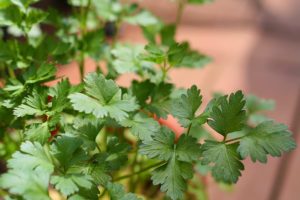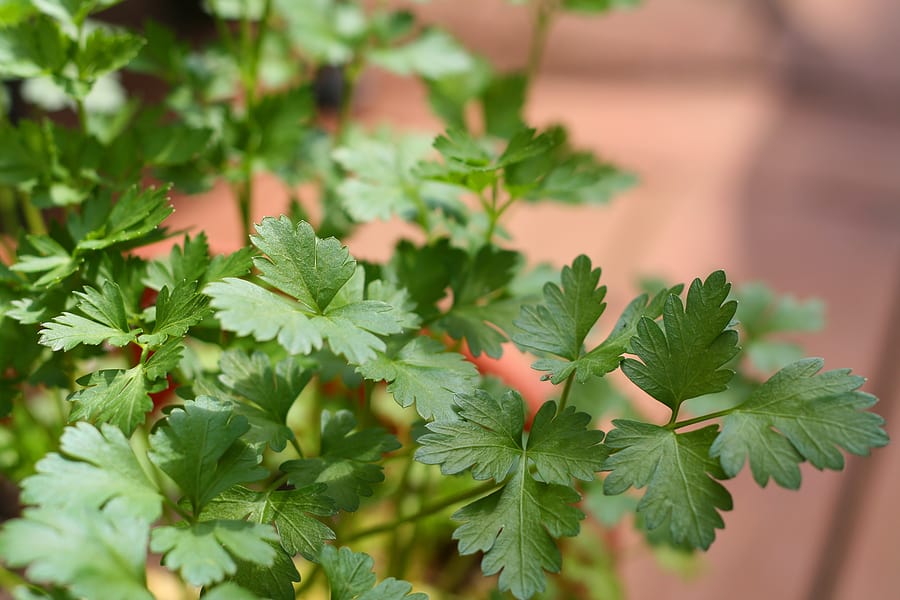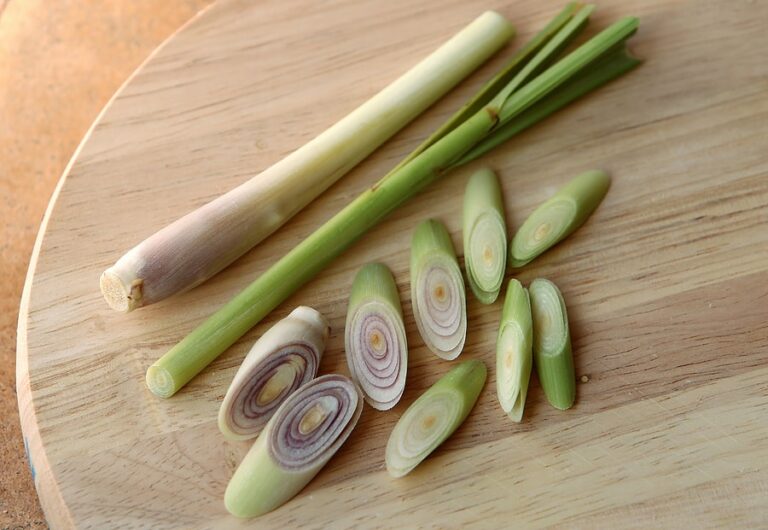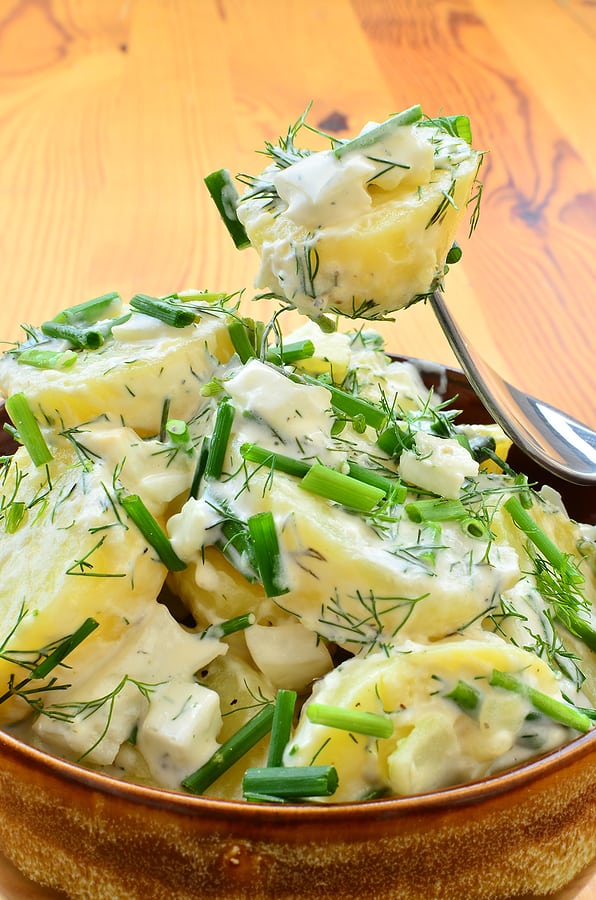Ways to Serve Parsley
Parsley has a clean, fresh, peppery flavor that makes it a good match for all savory dishes.
- Add chopped parsley to sliced tomatoes and toss with a vinaigrette. Add chopped parsley to scrambled eggs or an omelet.
- Add chopped parsley with butter or olive oil to make a sauce for boiled new potatoes, carrots, and other vegetables.
- Add chopped parsley to soups, stews, roasts, fish, poultry, stuffings, butter, and vinegar.
Parsley is an aromatic herb whose leaves and stems are edible. Parsley can usually be found year-round but is the youngest and most tender in spring.
Types of parsley
There are more than 30 varieties of parsley but two main types: curly-leafed and flat-leafed.
Curly-leaf parsley has finely divided ruffled leaves on fragile stems 8 to 12 inches (20-30 cm) tall. This bright green parsley has a mild taste and is often used as a garnish, not a flavoring. Sprigs of curly leaf parsley add color to meatloaves, casseroles, grilled meats, poultry, and non-green vegetables.
Flat-leaf parsley—also called Italian parsley–has flat green leaves that resemble celery leaves on stalks 18 to 24 inches (45-60 cm) tall. Flat-leaf parsley has a more pungent and persistent taste than curly parsley. It is the tastiest parsley for cooking.
Ways to serve parsley
- Use parsley fresh, dried, frozen, or marinated. It’s best used fresh.
- Parsley added at the last minute to cooked foods will be crisper, tastier, and greener.
- Add parsley to sandwich fillings, omelets, and salads. Add finely chopped parsley leaves to vegetables, meats, soups, stews, roasts, fish, sauces, stuffings, and vinegar.
- The high chlorophyll content of parsley makes it a natural breath freshener.
Parsley is an important ingredient in many herb mixes and sauces:
- Fines herbes bring together chervil, chives, parsley, and tarragon finely chopped, blended, and added to a cooked mixture shortly before serving.
- Bouquet garni combines parsley, thyme, and bay leaf bunched together in cheesecloth and used to flavor soups, stews, and broths.
- Persillade is a French mix of chopped parsley and garlic added as a flavoring or garnish to dishes such as lamb just before the end of cooking.
- Gremolata is an Italian garnish of minced parsley, lemon peel, and garlic sprinkled over cooked dishes such as braised veal shanks to add a fresh, tangy flavor.
- Salsa verde is a Spanish and Mexican green sauce based on tomatillos, green chiles, and parsley or cilantro used on fresh and cooked dishes.
- Tabbouleh is a Middle Eastern mix of cracked wheat mixed with chopped tomatoes, onions, parsley, mint, olive oil, and lemon juice served cold with crispbread.
Since parsley can be strong and pungent, it is best to taste it as it is added to foods and other herbs. That way you will get just the zing you are looking for and not more. Parsley should be added at the end of cooking so that its flavor is not lost.

How to choose parsley
Select parsley that is crisp and green with a fresh, clean aroma. Avoid sprigs that are yellow, brown, or wilted.
How to store parsley
Cut parsley for fresh use when possible. Cut parsley will keep in the refrigerator in a perforated plastic bag for 3 or 4 days. Before storing, wash parsley carefully by swishing it gently in cold water until it is clean, shaking off excess moisture, and wrap it in a paper towel before storing it in a plastic bag. If wilted, sprinkle parsley lightly with water before refrigerating. Whole or chopped parsley can be frozen.
Hang parsley in bunches to dry in the shade. Store dried parsley in an airtight container in a cool, dry, dark place.
How to prepare parsley
To mince or chop parsley, separate the leaves from the stems. Finely mince the leaves. Use the stems to flavor stocks.
Revitalize parsley by cutting the stems and standing the parsley in cold water for about an hour.
Parsley flavor partners
Parsley has a flavor affinity for beef, bulgur, capers, carrot, cauliflower, celery, celery root, chicken, clams, eggplant, fish, garlic, lemon, lentils, olive oil, onion, pasta, potato, rice, shallot, tomato, vermouth, zucchini, and most vegetables.
Parsley goes well with other herbs: basil, bay, capers, chervil, chili, chives, garlic, lemon balm, marjoram, mint, oregano, pepper, rosemary, sorrel, sumac, and tarragon.
Parsley nutrition
Parsley is rich in iron and vitamins A and C.
About parsley
Parsley is a biennial herb grown as an annual. It is a member of the carrot family and is native to southern Europe and the Mediterranean region. The ancient Greeks and Romans used parsley as a seasoning, but it was during the Middle Ages that parsley came into wide use in cookery.
The botanical name for curly-leafed parsley is Petroselinum crispum. The botanical name for flat-leafed parsley is Petroselinum neapolitanum.
More tips: How to Grow Parsley
Articles of interest:
Best Herbs for Container Growing
Garden Planning Books at Amazon:
- Vegetable Garden Almanac & Planner
- Kitchen Garden Grower’s Guide Vegetable Encyclopedia
- Vegetable Garden Grower’s Guide
- Tomato Grower’s Answer Book
More kitchen tips:
Bring your harvest to the table. Kitchen prep tips and easy recipes for the vegetables you grow. Click below for vegetable prep and recipes you can use now.
- Almonds
- Apples
- Apricot
- Aprium
- Artichoke
- Arugula
- Asparagus
- Avocado
- Bamboo Shoots
- Banana
- Basil
- Beans, Dried
- Beans. Long
- Beans, Shell
- Beans, Snap
- Beets
- Bitter Melon
- Blackberry
- Bok Choy
- Broccoli
- Broccoli Raab
- Brussels Sprouts
- Cabbage
- Cardoon
- Carrots
- Cauliflower
- Celeriac
- Celery
- Chard
- Chayote Squash
- Cherimoya
- Cherries
- Chestnut
- Chickpea
- Chinese Cabbage
- Chives
- Cilantro
- Citron
- Clementine
- Collards
- Coriander
- Corn, Sweet
- Corn, Baby
- Corn Salad, Mache
- Cranberry
- Cress
- Cucumber
- Daikon
- Dandelion
- Dill
- Eggplant
- Endive, Belgian
- Endive and Escarole
- Fava Beans
- Fig
- Florence Fennel
- Garlic
- Ginger
- Grapefruit
- Grapes
- Guava
- Horseradish
- Jerusalem Artichoke
- Jicama
- Jujube
- Kale
- Kiwifruit
- Kohlrabi
- Kumquat
- Leeks
- Lemongrass
- Lemons
- Lettuce
- Lime
- Mache (Corn Salad)
- Mandarin Orange
- Mango
- Maple Syrup
- Marjoram
- Melons
- Michihili
- Mint
- Mizuna
- Mushrooms
- Mushrooms, Cremini
- Mustard Greens
- Napa Cabbage
- Nectarine
- Okra
- Olives
- Olive oil
- Onions
- Oranges
- Oregano
- Parsley
- Parsley Root
- Parsnips
- Passion Fruit
- Pawpaw
- Peaches
- Pears
- Peas, Garden Snap
- Peas, Snow
- Pei Tsai
- Peppers, Chili
- Peppers, Sweet
- Persimmon
- Pineapple
- Pineapple Guava
- Plantain
- Plums
- Pluots
- Pomegranate
- Potatoes
- Prickly Pear
- Pumpkin
- Quince
- Radicchio
- Radishes
- Raspberries
- Rosemary
- Rhubarb
- Rutabaga
- Sage
- Salsify
- Sauerkraut
- Savory
- Shallots
- Sorrel
- Spinach
- Squash, Summer
- Squash, Winter
- Strawberries
- Sunchokes
- Sunflower
- Sweet Potato
- Swiss Chard
- Tangerine
- Taro
- Tarragon
- Thyme
- Tomatillo
- Tomato
- Turnip
- Turnip Greens
- Yams







